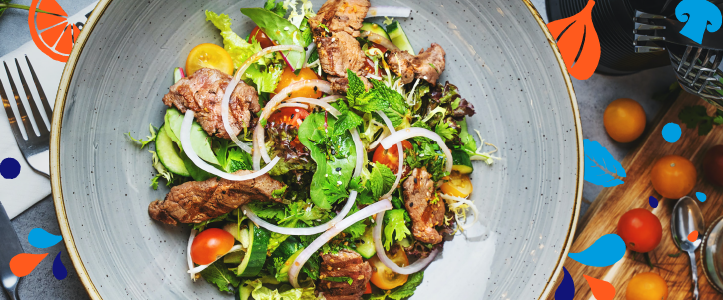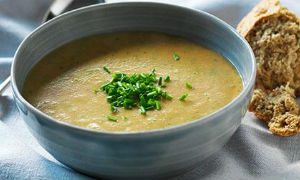
There is no specific diet for diabetes. But the foods you eat not only make a difference to how you manage your diabetes, but also to how well you feel and how much energy you have. For example carbohydrates you eat and drink are broken down into glucose. The type, and amount, you consume can make a difference to your blood glucose levels and diabetes management.
This information will help you get to know the five main food groups that make up a healthy, balanced diet.
Eating from the main food groups

How much you need to eat and drink is based on your age, gender, how active you are and the goals you’re aiming for. But no single food contains all the essential nutrients your body needs.
That’s why a healthy diet is all about variety and choosing different foods from each of the main food groups every day.
And when we say balanced, we mean eating more of certain foods and less of others. But portion sizes have grown in recent years, as the plates and bowls we use have got bigger. And larger portions can make it more difficult for you to manage your weight. We’ve got more information for you about managing a healthy weight.
We’ve highlighted the benefits of each food group below – some help protect your heart and some affect your blood sugar levels more slowly – all really important for you to know. Get to know them and how healthy choices can help you reduce your risk of diabetes complications.
You can learn more about a healthy diet for diabetes with our Food Hacks section in our Learning Zone.
What are the main food groups?
- Fruit and veg
- Starchy foods, like bread, pasta and rice
- Protein foods, like beans, pulses, nuts, eggs, meat and fish
- Dairy and alternatives
- Oils and spreads
Have type 1 diabetes? Get the basics on what to eat.
Have type 2 diabetes? Get the basics on what to eat.
Go straight to our recipes.
Fruit and vegetables
Having diabetes doesn’t mean you can’t have fruit. Fruit and vegetables are naturally low in calories and packed full of vitamins, minerals and fibre. They also add flavour and variety to every meal.
Fresh, frozen, dried and canned – they all count. Go for a rainbow of colours to get as wide a range of vitamins and minerals as possible. Try to avoid fruit juices and smoothies as they don’t have as much fibre.
If you’re trying to limit the amount of carbs you eat, you might be tempted to avoid fruit and veg. But it’s so important to include them in your diet every day. There are lower carb options you can try and we also have a low carb meal plan you can try.
Fruit and vegetables can help protect against stroke, heart disease, high blood pressure and some cancers – and when you have diabetes, you’re more at risk of developing these conditions.
Benefits
- Help to keep your digestive system working well
- Help protect the body from heart disease, stroke and some cancers.
How often?
Everyone should aim to eat at least five portions a day. A portion is roughly what fits in the palm of your hand.
Examples of what to try
- sliced melon or grapefruit topped with unsweetened yogurt, or a handful of berries, or fresh dates, apricots or prunes for breakfast
- mix carrots, peas and green beans into your pasta bake
- add an extra handful of peas to rice, spinach to lamb or onions to chicken
- try mushrooms, cucumber, spinach, cabbage, cauliflower, broccoli, celery and lettuce for lower carb vegetable options
- try avocados, blackberries, raspberries, strawberries, plums, peaches and watermelon for lower carb fruit options
Check out our recipes to help you eat a healthy diet for diabetes – we’ve got lots of delicious main meals packed full of vegetables, and fruity breakfast options.
Starchy foods
Starchy foods are things like potatoes, rice, pasta, bread, chapattis, naan and plantain. They all contain carbohydrate, which is broken down into glucose and used by our cells as fuel. The problem with some starchy foods is that it can raise blood glucose levels quickly, which can make it harder for you to manage your diabetes. These foods have something called a high glycaemic index (GI) – we’ve got loads more information about this.
There are some better options for starchy foods – ones that affect blood glucose levels more slowly. These are foods with a low glycaemic index (GI), like wholegrain bread, whole-wheat pasta and basmati, brown or wild rice. They also have more fibre, which helps to keep your digestive system working well. So if you’re trying to cut down on carbs, cut down on things like white bread, pasta and rice first.
Benefits
- The fibre helps to keep your digestive system healthy
- Some affect your blood sugar levels more slowly
- Wholegrains help protect your heart
How often?
Try to have some starchy foods every day.
Examples of what to try
- two slices of multigrain toast with a bit of spread and Marmite or peanut butter
- brown rice, pasta or noodles in risottos, salads or stir-fries
- baked sweet potato with the skin left on – add toppings like cottage cheese or beans
- boiled cassava, flavoured with chilli and lemon
- chapatti made with brown or wholemeal atta.
Try our chapatti recipe – just one option for a tasty lunch.
Protein foods like beans, nuts, pulses, eggs, meat and fish
Meat and fish are high in protein, which keeps your muscles healthy. But a healthy diet means less red and processed meat – they’ve been linked to cancer and heart disease. Oily fish like mackerel, salmon and sardines have a lot of omega-3 oil, which can help protect the heart.
Benefits
- Helps keep your muscles healthy
- Oily fish protects your heart
How often?
Aim to have some food from this group every day. Specifically at least 1 or 2 portions of oily fish each week. But you don’t need to eat meat every day.
Examples of what to try
- a small handful of raw nuts and seeds as a snack or chopped with a green salad
- using beans and pulses in a casserole to replace some – or all – of the meat
- eggs scrambled, poached, dry fried or boiled – the choice is yours
- grilled fish with masala, fish pie, or make your own fishcakes
- chicken grilled, roasted or stir-fried
We’ve got lots of healthy recipes to choose from – like our bean stew or try one of our fish dishes.
Dairy foods and alternatives
Milk, cheese and yogurt have lots of calcium and protein in – great for your bones, teeth and muscles.
Check for added sugar in lower-fat versions of dairy foods, like yoghurt. It’s better to go for unsweetened yoghurt and add some berries if you want it sweeter. If you prefer a dairy alternative like soya milk, choose one that’s unsweetened and calcium-fortified.
Benefits
- Good for bones and teeth
- Keeps your muscles healthy
How often?
We all need some calcium every day.
Examples of what to try
- a glass of milk straight, flavoured with a little cinnamon or added to porridge
- natural or unsweetened yogurt with fruit or on curry
- cottage cheese scooped on carrot sticks
- a bowl of breakfast cereal in the morning, with skimmed or semi-skimmed milk
- a cheese sandwich for lunch, packed with salad
- a refreshing lassi or some plain yogurt with your evening meal
Oils and spreads
We need some fat in our diet but we need less saturated fat. This is because some saturated fats can increase cholesterol in the blood, increasing the risk of heart diseases and stroke. These less healthy options are butter, palm nut oil and coconut oil.
Healthier fats are foods like olive oil, vegetable oil, rapeseed oil, spreads made from these oils, and nut butters.
Benefits
- Unsaturated fats help protect your heart
Examples of what to try
- A drizzle of olive oil on your salad
- Peanut butter on your wholemeal toast
Foods high in fat, salt and sugar
You don’t need any of these as part of a healthy diet. The less often, the better. But we know you’re bound to eat these foods from time to time, so it’s really important to know how they might affect your body.
These foods include biscuits, crisps, chocolates, cakes, ice cream, butter and sugary drinks. These sugary foods and drinks are high in calories and raise blood sugar levels, so go for diet, light or low-calorie alternatives. And the best drink to choose is water – it’s calorie free.
They’re also high in unhealthy saturated fats, so they aren’t good for cholesterol levels and your heart.
And they can also be full of salt – processed foods especially. Too much salt can make you more at risk of high blood pressure and stroke. You should have no more than 1 tsp (6g) of salt a day.
We don't recommend 'diabetic' ice cream or sweets. It's now against the law to label any food as diabetic and there's no evidence to suggest that food for diabetics offer any benefits over eating a healthy balanced diet.
Tips for cutting these out
- Cook more meals from scratch at home, where you can control the amount of salt you use.
- Check food labels – look for green and orange colours. We’ve got more information to help you read labels and we’re campaigning for things to get more consistent and less confusing.
- Try unsweetened teas and coffees – they’re better than fruit juices and smoothies as they don’t add any extra calories and carbs.
- Banish the salt shaker from the table – black pepper, herbs and spices are great ways of adding extra flavour to your food.
- Making your own sauces, like tomato ketchup and tandoori marinades.
